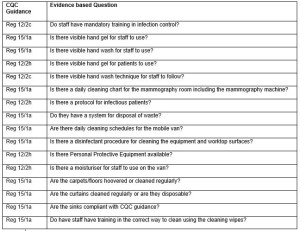Background
Background Healthcare-Associated Infections (HAIs) are recognised as the most common adverse events in healthcare settings (1). It is essential that all healthcare workers receive proper training and education in infection control and take responsibility for the decontamination of equipment and the environment used in patient care (2). However, the World Health Organization (WHO) reports a widespread lack of hand hygiene culture in outpatient departments globally (3). The National Breast Screening Programme (NHSBSP) was established in 1988, introducing mobile breast screening units to improve access for women in the community. Currently, these mobile units are not monitored by the Care Quality Commission (CQC). This study aims to assess infection control compliance within breast screening mobiles by developing a reliable data collection tool. The audit framework is based on the Health and Social Care Act 2008 (4), focusing specifically on Regulation 12 and Regulation 15. Potential gaps in infection control regulations will be examined through a literature review and an evaluation of the study results.
Methodology
An audit tool was devised by the investigator against CQC national specifications. A mixed methods design was utilized using questionnaires, observation and interviews. The Researcher Administered Audit (RAA) was completed by the investigator on four mobile breast screening units.The sampling method selected was convenience sampling. Bowling (5) clarifies that convenience sampling means participants are easier to recruit if they are near at hand and therefore more likely to respond. The results from the RAA were used to construct a semi-structured interview questionnaire based on CQC guidance. The staff who worked on the breast screening mobile units were questioned about their perceptions and experiences of infection control. Thematic analysis was judged the most appropriate method to analyse the data from the interviews.
